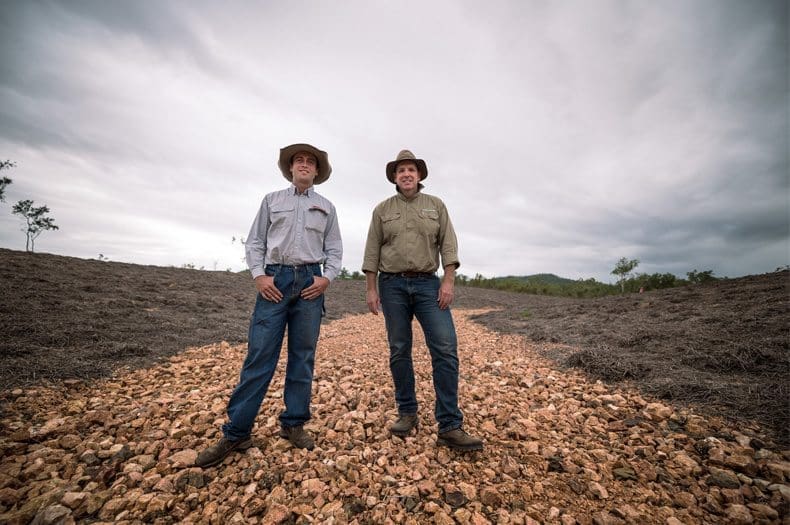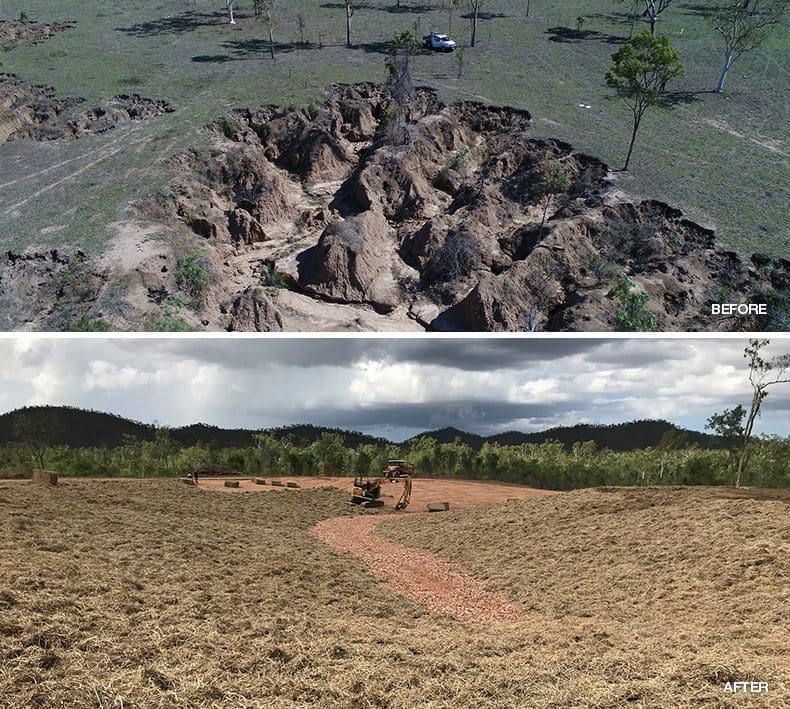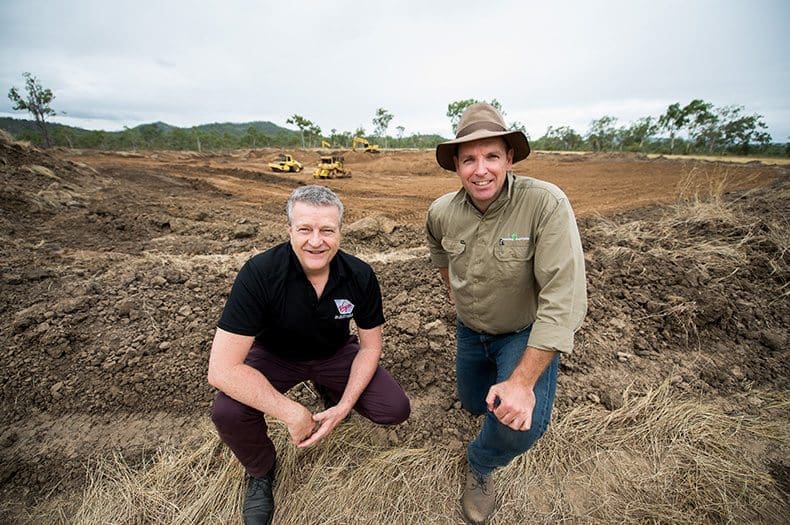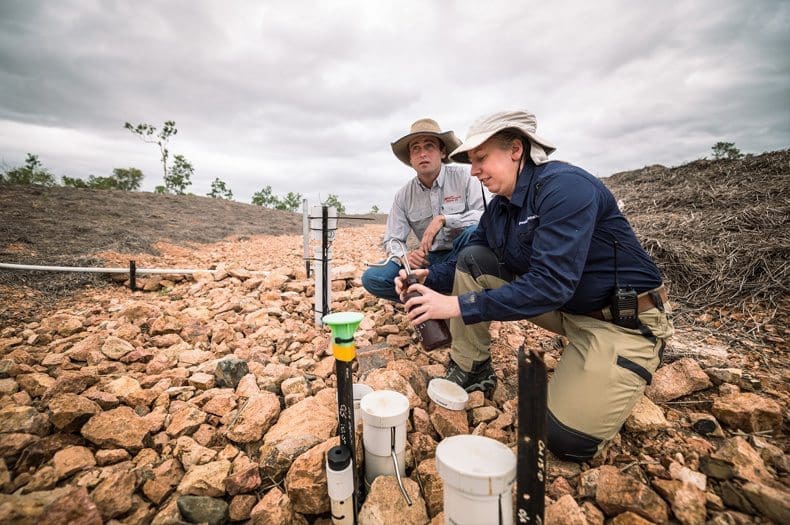
Landholder Bristow Hughs inspects a remediated gully on his Strathalbyn property with CEO of Greening Australia, Brendan Foran.
GREENING Australia has today announced the results from the first phase of its Reef Aid program, with a trial to reduce sediment flowing onto the Great Barrier Reef (the Reef) resulting in a 97 per cent improvement in water quality.
Known as the Gully Remediation Project (the Project), the trial is taking place at the Strathalbyn Station, a cattle property three hours south of Townsville.
Greening Australia is working with the Queensland Government’s Great Barrier Reef Innovation Fundand the Station’s landholders, the Hughes Family, on the Project.
With the Federal Government recently setting aside $200 million of its $500 million rescue package for the Great Barrier Reef to improve the Reef’s water quality, the results of the Project are set to have a positive impact for the health of the Reef.
Greening Australia Program Adviser, Damon Telfer, noted that the gullies targeted at Strathalbyn Station have exported on average 956 tonnes per hectare per year since 1945, equating to 550,000 tonnes of sediment to the Burdekin over that period, of which at least 65pc is capable of reaching the Great Barrier Reef.
Before and after:
The eroding gully at Strathalbyn Station before and after remediation.
“To date, rigorous scientific and economic cost-benefit evaluations of this type of gully remediation has been very limited, so this Project is crucial to improving our restoration techniques, cost effectiveness and ultimately the health of the Reef,” Mr Telfer said.
Launched in 2016 alongside advocate and Virgin Australia founder, Sir Richard Branson, Greening Australia’s flagship Reef Aid project aims to rebuild eroding gullies and restore vital coastal wetlands across the Great Barrier Reef catchment.
Brendan Foran, CEO of Greening Australia, said: “Since launching the public fundraising appeal for Reef Aid two years ago with the support of Virgin Australia, we’ve seen an overwhelmingly positive response from the government, private donors and partners. Protecting the Reef demands big investment, yet it is an imperative that we are looking after one of Australia’s greatest icons for future generations to enjoy.”
Greening Australia aims to secure $132 million by 2030. It will also raise funds from its private supporters, including from Virgin Australia, whose support to date has been significant in its catalytic effect in the first phase of the Reef Aid program.
Virgin Australia General Manager of Group Sustainability, Rob Wood, said that Virgin Australia is passionate about conserving one of the biggest natural ecosystems on earth.
Rob Sharp, Group Executive, Virgin Australia, and Brendan Foran, CEO of Greening Australia, inspect the next phase of activity at Strathalbyn Station.
“Virgin Australia is focused on supporting projects that provide practical solutions and our partnership with Greening Australia is helping to make a real difference to improving the Reef’s water quality,” Mr Wood said.
“The Reef Aid project has achieved fantastic results to date and we look forward to continuing to support the great work of Greening Australia.”
On 8 June, Virgin Australia will mark World Oceans Day by fundraising at its major ports, while its pilots will raise awareness of the issue with on-board announcements on flights over the Reef.
Greening Australia is now seeking support to significantly scale up the project to play an integral role in meeting the goals set out in the Australian and Queensland Governments’ Reef 2050 Plan, which includes a 50 per cent reduction in sediment load by 2030.
Based on the success of the latest trial program, Greening Australia plans to roll out the techniques used at Strathalbyn to erosion hotspots along the Reef.
Landholder Bristow Hughes and Reef Aid Program Leader, Dr Lynise Wearne test the water quality at Strathalbyn Station.
Funding and support
The first stage of Reef Aid is partially funded by the Australian and Queensland governments, corporate partnerships and multiple private philanthropists.
The Gully Remediation Project has been funded by the Queensland Government and Greening Australia to identify more innovative and cost-effective gully remediation techniques.
Source: Greening Australia






In response to both Paul’s and Frank’s comments above; the contributing catchment above this reclaimed gully site was in-fact shallow ripped (on the contour) two years ago and sown with a range of grasses and legumes. The contour ripping was done with the scarifier tynes (not deep ripper tynes) on a road grader. The depth of ripping was only to 100mm to avoid exposing the highly dispersible sodic clays that are under these soils. Some legumes did establish which will eventually enhance pasture growth, increase infiltration and reduce runoff.
In response to Bob’s comment (hello Bob – long time no speak!), yes there are 100s of these gully networks, that’s why those that are closest to the lower reaches of the major rivers, such as the Strathalbyn site, are the high priority ones to treat. As they say, there is not enough money in the Bank of England to treat all of the gullies.
Paul Franks, you are correct to say increased grass cover is the key to lowering sediment runnoff, however, in this case, the soil type showcased in this trial is sodic soil. These soil types are highly erosive and grow very little grass as a result of their chemical makeup.
Bristow Hughes was at the Townsville parlimentary hearing into land clearing earlier this year and he spoke at length on this trial. One of the things he said was it was very expensive to achieve this result, but they had not only reduced the erosion by 97 percent, they have turned unproductive, fragile land into productive grazing land where stock are grazed.
Ripping ground to break up the surface and allow water to penetrate is also a very good practice, however, with soil types as fragile as the sodic soils in the trial at Strathalbyn, deep ripping would only increase the rate of erosion. Granted, these points are not included in the above story, so your apparent disaproval of the trial, based on the evidence given is understandable.
My point is, you are correct in a general sense, but in this particular case your preferred method is not feasible. The lack of information in the article left you ignorant of some important facts relating to the trial.
Couldn’t agree more. There must be hundreds of gully situations like this .
How much is GA prepared to spend?
Will the grazing management change for livestock as well as marsupials.
Looking at the grass cover in the photo, no wonder there is bad erosion. The most effective way to stop and repair erosion is to have ample grass coverage. There are other benefits of lots of grass coverage which includes ability to use fire to control woody weeds and ability to improve soil fertility. Correctly ripping ground improves water infiltration so you get even more grass. Research done by members of the Qld DPI back in the day when agriculture in Queensland was not a dirty word released a booklet showing for coastal speargrass country you really only want to use 30% of the grass load per year.
A city media outlet running the same story seems to be indicating this project is costing ~$500 000 a hectare. https://www.brisbanetimes.com.au/environment/conservation/great-barrier-reef-sediment-flow-reduced-by-97-per-cent-at-test-site-20180517-p4zfwb.html